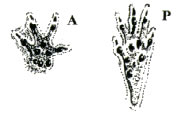| Geographic Range |
it is found throughout Europe, except northern
Scandinavia and Finland, east to the Altai and Himalayan mountains. It is
also found in parts of central and southwestern Asia, Himalayas, northwestern
Africa, British Isles. |
| Physical Characteristics |
fur is soft, and the tail is only moderately
hairy. The dorsal area is grayish brown, with yellow or red mixed in. The
underparts are white or light grey, often with an oblog yellow spot on the
throat. The feet are white. The tail is not prehensile. Eyes and ears are
big, and they allow a good vision at night and predator avoidance. The sense
of smell is highly developed. |
| Behaviour |
it is a very good climber, jumper, and swimmer.
It is nocturnal or crepuscular. Males normally live in an area of approximately
109 meters in diameter, while females inhabit an area of 64 meters in diameter.
It builds burrows and tunnel systems below ground. These burrows are typically
about 3 centimeters wide and 8-18 centimeters below the surface. |
| Habitat |
it lives anywhere it can find shelter, even
if it prefers grassy fields, cultivated areas and forests. It may move into
human habitations in the fall and winter but usually digs deep burrows and
builds a nest of shredded grass and leaves at the end of a tunnel. |
| Food habits |
it feeds on roots, seeds, berries, nuts, grasses,
insects. |
| Reproduction |
the breeding season is from March through
early winter. Females produce up to four litters annually, with four to
seven young each litter . The gestation period is of 21-26 days. The young
are born with a thin coat af dark fur and open their eyes after 13 days. |









 Apodemus sylvaticus
Apodemus sylvaticus